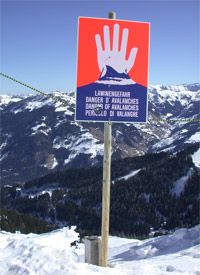Avoiding an Avalanche
Avalanches are most common on smooth, steep slopes, without a lot of obstacles or tree cover. Unfortunately, these are the sorts of areas backcountry enthusiasts like to use for skiing, hiking and snowboarding. Also, some popular activities, like high marking (driving a snowmobile as high as possible up a steep incline and making an arc back down the slope) are exactly the kind of actions that will likely start an avalanche. This makes avalanches in areas where people are likely to be inevitable.
Preventing an avalanche is far easier than surviving one. The most important step is to be aware of your surroundings and to monitor weather conditions closely. Most countries use a warning system to tell people how likely avalanches are. Lots of parks and resorts have hotlines and web pages with up-to-date information about the area avalanche forecast. In addition to keeping up with this information, you should:
Advertisement

- Take an approved avalanche safety course before going into the backcountry.
- Take a partner with you.
- Carry a shovel, a rescue beacon and an avalanche probe. Make sure your rescue beacon is under your outer layer of clothing, has fresh batteries and is set to "transmit."
- Measure the angle of the slope. Most outdoor supply stores sell small, inexpensive inclinometers for this purpose.
- Look out for shady areas and places where snow collects.
- Be alert for fracture lines, hollow sounds, and "whumphing" noises, which can all signal an impending avalanche.
- Dig a quick pit -- a deep pit with smooth sides in which all the layers are visible -- to examine the snowpack.
- Test the stability of the snowpack. The U.S. Forest Service has tutorials on three basic tests -- shovel shear, compression and rutschblock. Another common test is called the stuffblock test. You can also test use a belay system and kick or cut down cornices to test whether the terrain below is stable.
- Avoid obvious avalanche tracks and areas with previous avalanche activity.
- Travel above avalanche-prone areas instead of through the center. If you must cross a hazardous slope, do so one at a time to minimize risks.
- Never travel above your partner.
- Do not assume that existing tracks from other people mean that an area is safe.
But even if you follow all of these steps, you could still be caught in a naturally-occurring avalanche or one started by someone else. Next, you'll learn the steps you can take to survive an avalanche.
